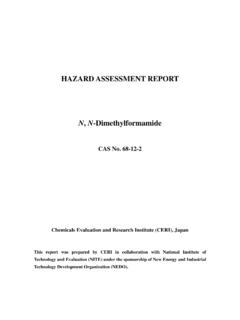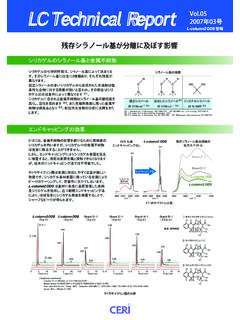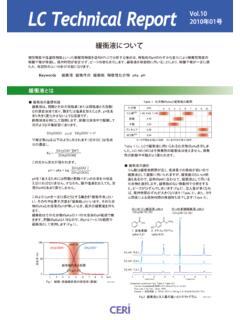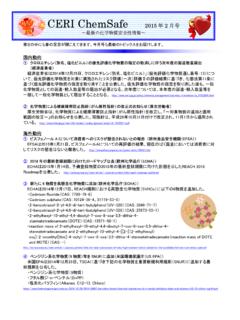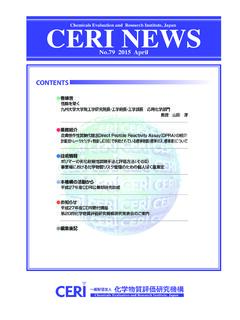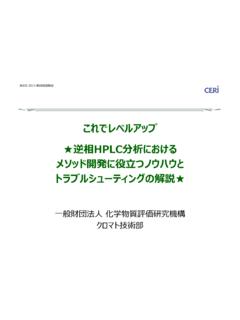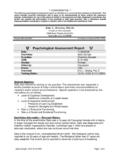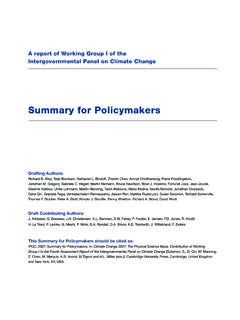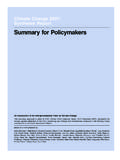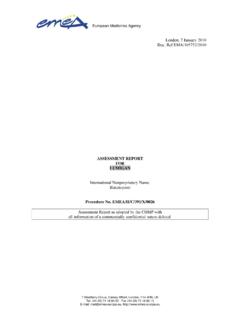Transcription of HAZARD ASSESSMENT REPORT Hydrazine - …
1 HAZARD ASSESSMENT REPORT Hydrazine CAS No. 302-01-2 Chemicals Evaluation and Research Institute (CERI), Japan This REPORT was prepared by CERI in collaboration with National Institute of Technology and Evaluation (NITE) under the sponsorship of New Energy and Industrial Technology Development Organization (NEDO). iiPreface to the English Version of the HAZARD ASSESSMENT Reports For six years from April 2001 to March 2007, Chemicals Evaluation and Research Institute (CERI/Japan) was engaged in a project named Chemical Risk ASSESSMENT and Development of Risk ASSESSMENT Methods under "Comprehensive Chemical Substance ASSESSMENT and Management Program" funded by New Energy and Industrial Technology Development Organization (NEDO/Japan).
2 Under this project, about 150 chemical substances were selected among those designated as Class-I Chemicals in the Law for Pollutant Release and Transfer Register and Promotion of Chemical Management (hereafter PRTR Law)1). The selection criteria of these chemicals were their priorities for risk ASSESSMENT based on their production levels and environmental/human health concerns. CERI developed the HAZARD ASSESSMENT reports of these selected chemical substances based on the review and evaluation of the environmental and human health HAZARD data obtained from the existing evaluation documents released by the regulatory agencies and international organizations as well as those from the published scientific literatures.
3 The data review and compilation of the reports were conducted according to the guidelines2) and the guidance manual2) developed for this project. The proposed HAZARD ASSESSMENT reports by CERI were reviewed by the experts in the relevant scientific fields from both inside and outside this project for accuracy, relevance and completeness. The final reports were published in Japanese after going through the deliberation by the Council on Chemical Substances under the Ministry of Economy, Trade and Industry (METI/Japan), which is responsible for regulation of chemical substances in Japan.
4 This project was the first attempt in Japan to develop comprehensive HAZARD assessments of chemical substances for application in risk ASSESSMENT . In order to share the outcomes of the project globally, CERI independently selected the following seven chemical substances and developed the English version of the HAZARD ASSESSMENT reports: (1) Acetaldehyde (2) Chlorobenzene (3) Hydrazine (4) N, N-Dimethylformamide (5) Poly(oxyethylene) nonylphenyl ether (6) 3,3 -Dichloro-4,4 -diaminodiphenylmethane (7) Dimethyl 2,2-dichlorovinyl phosphate (Dichlorvos) 1) Details of the PRTR Law, the list of designated chemical substances, and release data in Japan are available on Internet at: 2) Guidelines and the guidance manual in Japanese are available on Internet at.
5 Also, the initial risk ASSESSMENT reports in Japanese developed in this project which include calculations of margin of exposure based on the result of HAZARD ASSESSMENT and exposure ASSESSMENT , are available on Internet at: iiiWe hope that the HAZARD ASSESSMENT reports from our project contribute to the risk ASSESSMENT and management of chemical substances globally, and appreciate your feedback. Date: May, 2007 Chemicals Evaluation and Research Institute 1-4-25 Koraku, Bunkyo-ku, Tokyo 112-0004, Japan ivSummary In this document, Hydrazine is defined as the generic name for Hydrazine anhydride and Hydrazine hydrate, unless otherwise noted.
6 Hydrazine anhydride is a colorless, weakly basic and hygroscopic liquid with a boiling point of C and a vapor pressure of kPa at 20 C. It is miscible with water and alcohols. Hydrazine hydrate is a colorless liquid with a boiling point of 118-119 C and a vapor pressure of 1 kPa at 20 C. It is miscible with water and alcohols and has strong alkaline and reducing properties. Hydrazine anhydride is used for rocket fuel and several tons per year was produced in Japan.
7 Hydrazine hydrate is used mainly as raw material for foaming agents of plastics and can cleaning agents. Domestic production and export volumes of Hydrazine hydrate in 2001 were 15,373 and 2,702 tons in Japan, respectively. Considering the uses of Hydrazine and the annual emission data for 2001 in Japan (the 2001 PRTR data), the main release route is through emmisions during the use process of Hydrazine or products containing Hydrazine . As the scenario of Hydrazine releases in Japan, it was estimated that 65 tons of Hydrazine was released annually to air, and 216 tons to water.
8 Hydrazine released to the aquatic environment is not eliminated by volatilization from the surface of water. Hydrazine is not hydrolyzed but easily oxidized by dissolved oxygen in the aquatic environment and degraded. Hydrazine at a low concentration can be eliminated by biodegradation. Low bioaccumulation is suggested in aquatic organisms. Many studies have been conducted to assess the toxic effects of Hydrazine on organisms in the environment using indices including growth inhibition, mortality, immobilization, growth, anomaly and germination.
9 In a growth inhibition study of Hydrazine in algae, the 72-hr EC50 was mg/L in freshwater alga. The 72-hr NOEC was mg/L in the freshwater alga and the 8-day NOEC was mg/L in the marine alga. The acute toxicity of Hydrazine to invertebrates has been reported in freshwater water fleas. The 24-hr EC50 values for immobilization in water fleas ranged to mg/L, and the 48-hr EC50 was mg/L, and the 48-hr LC50 in an amphipod was mg/L. The acute toxicity of Hydrazine to fish has been studied in freshwater fish, fathead minnow, bluegill, goldfish, zebrafish, guppy and channel catfish.
10 The 96-hr LC50s of Hydrazine ranged from to mg/L and the lowest value was mg/L in guppy. The 96-hr LC50 in marine three-spined stickleback was mg/L. In other effects, it has been reported that exposure of Hydrazine anhydride to fish embryos and amphibian larva caused anomalies. The lowest value of toxicity in aquatic organisms is mg/L as the 8-day NOEC for growth inhibition of the marine alga. Hydrazine is absorbed rapidly in inhalation, oral and dermal administration to experimental animals.

